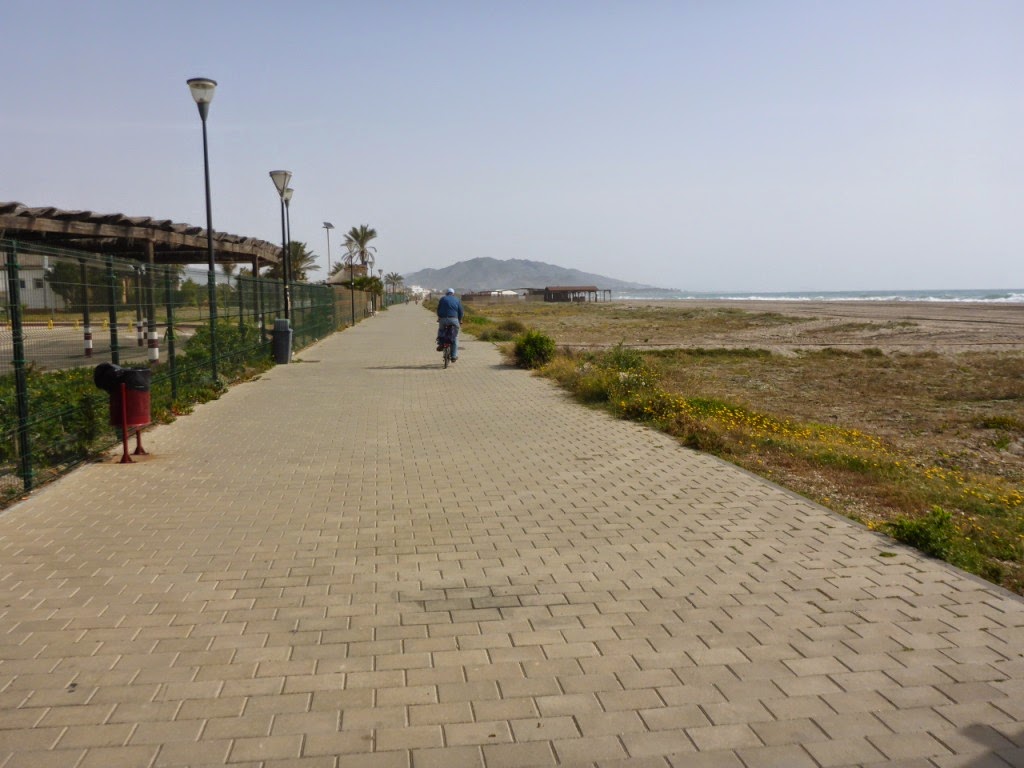Mercredi 15 Avril 2015
Jens va voir les vagues après le petit-déjeuner et revient
en pensant qu’elles sont encore grosses. Il va visiter Antonio et on décide
d’attendre encore un peu. Il va payer la marina, qui nous fait un bon prix et
moi je vais faire des photos du bateau norvégien « Oslo Bulk 2 » qui
est en train de charger du gypse. Puis, vers 11 h, Jens va revoir les vagues et
revient en disant qu’elles ont bien diminuer et qu’on peut partir. Nous le faisons
donc et, en sortant du port, voyons que le Oslo Bulk 2 est en fait enregistré à
Singapore. Et nous sortons du port. La houle d’hier est encore bien présente,
1m-1,5 m et de trois-quart en face. Maja reprend ses habitudes de cabrioler
dans tous les sens, cela bouge bien, ça va mais il faut faire attention de bien
se tenir tout le temps, et il pleut et il va pleuvoir toute la journée. Nous
allons au moteur, une petite heure avec le foc dans l’après-midi, c’est tout.
Je suis perchée sur la chaise de pilotage et me cramponne, mais au moins j’ai
le temps de faire mes exercices pour ma main. Pour rentrer ou sortir du «trou»
(qui n’est plus mon trou, Jens y fait souvent une petite sieste), il faut que
Jens m’aide. On ne voit personne, sauf un bateau de pêche, la visibilité est
mauvaise et on se croirait en Norvège en Novembre. Mais, en début d’après-midi,
je vois un couple de fous de bassan, ces grands oiseaux qui sont si beaux. Le
temps passe, entre siestes, manger un peu et écouter de la musique. Quand le
jour tombe, nous voyons enfin le soleil, 5 mn et un peu tard. Nous approchons
de Cartagena et voyons par AIS que plusieurs navires sont ancrés devant le
port à attendre, le premier étant un navire d’EDF-Suez. Nous les longeons et entrons dans
le port à 21 h 30. Le port de Cartagena est une baie naturelle bien protégée. Nous
trouvons la marina, et, ô bonheur, on voit qu’ils ont des pontons flottants où
on peu se mettre en long. On se met à une place libre, entre des grands
voiliers et on verra demain s’il faut déménager. Bien contents d’arriver après
dix heures de navigation et 50 MN (90 km).
Wednesday, April 15, 2015
Jens goes to see the waves after breakfast and returns
thinking they are still big. He visits Antonio and decides to wait a little. He
pays the marina, which makes us a good price and I take pictures of the
Norwegian ship "Oslo Bulk 2" which is being loaded with gypsum. Then
around 11 am Jens goes again to see the waves and comes back saying they have
decreased and that we can leave. We do so, and coming out of the harbor, see
that the “Oslo Bulk 2” is actually registered in Singapore. And we leave the
port. The swell of yesterday is still present, 1m-1.5m from three-quarter front.
Maja resumes her habits of cavorting in every direction, it is moving well, it’s
OK but we have to be very careful to hold on all the time, and it's raining and
it's going to rain all day. We are motoring, we have one hour with the jib in
the afternoon, that's all. I am perched on the pilot chair and hold on all the time, but
at least I have time to do exercises for my hand. To enter or exit the
"hole" (which is not my hole anymore, Jens uses it often to take a
nap) Jens must help me. We don’t see anyone except a fishing boat, the
visibility is bad and it is like in Norway in November. But by early afternoon,
I see a couple of gannets, these large birds that are so beautiful. Time
passes, between naps, eating a bit and listening to music. When night falls, we
finally see the sun, 5 minutes and a little late. We are approaching Cartagena
and see on AIS several ships anchored at
the harbour entrance, waiting, the first one being an EDF-Suez ship. We pass along
them and enter the harbor at 9:30 pm. The harbor of Cartagena is a sheltered
natural bay. We find the marina, and, oh joy, we see that they have floating pontoons
where we can tie along. We find a place between big sailing boats and we'll see
tomorrow if we have to move. Glad to arrive after ten hours of navigation and
50 NM (90 km).
Oslo Bulk 2
Bye, bye Garrucha
En bas
Down
En haut
Up
Un bateau de pêche
A fishing boat
Jens dans mon "trou"
Jens in my "hole"
Je fais mes exercices
I am doing my exercises
Cabo Tiñoso
Les navires qui attendent devant Cartagena
The big ships waiting in front of Cartagena
Première fois qu'on voit le soleil aujourd'hui
We see the sun for the first time today
Nous entrons dans le port de Cartagena
We enter Cartagena harbor
Garrucha






















